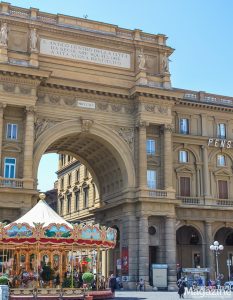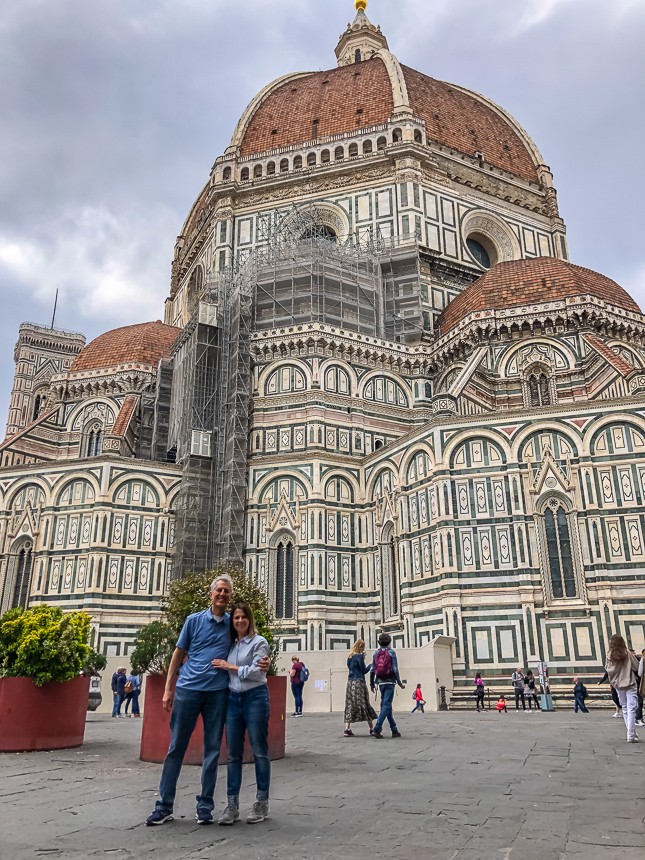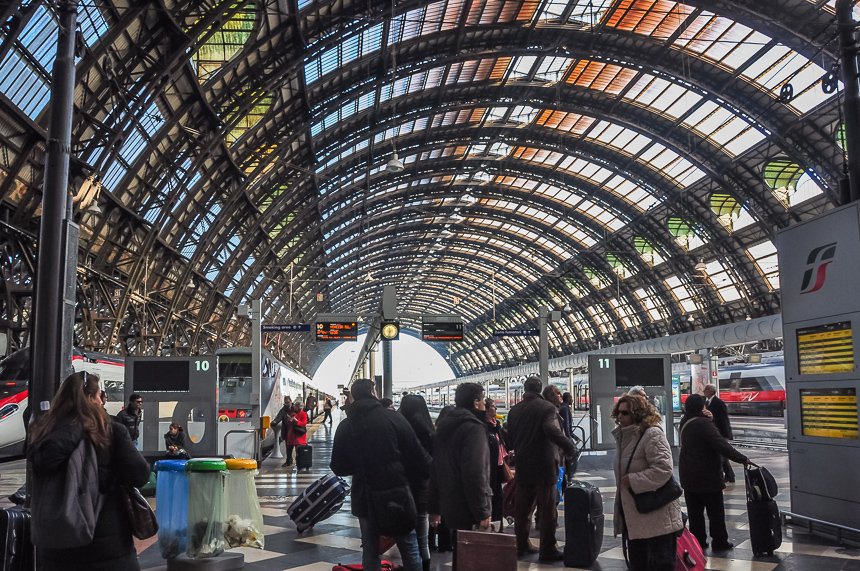
Saul Schwartz took his wife Fern by the hand and crossed the great pond for the first time since the pandemic on a mission to fall in love with Europe again. And what better place to rekindle that romance than in Northern Italy?
Milan, Florence, Pisa and Venice are all dreamy destinations and, if planned right, can be visited in less than 2 weeks. Saul and Fern left nothing to chance and had organized everything in advance.
What is the best way to spend 3 days in Florence? Let them show you:
By Saul Schwartz
Walking tour of Florence

To get better oriented, we spent our first morning in Florence on a two-hour walking tour through FreeTour.com, with the tour provider All Around Florence. The focus was on Renaissance and Medici Tales. At the end of the tour, we paid a tip of 20 Euros.
The tour began outside the Basilica di San Lorenzo church, next to the marble statue of Giovanni Medici sitting on a small throne. Our guide Alberto was extremely knowledgeable. He first told us about the powerful Medici family and their fame acquired through banking.
The Medici Monument to Giovanni delle Bande Nere is an Italian Renaissance sculpture in marble. The work took from 1540 to after 1560 to carve. One bas relief shows the Medici coat of arms. The statue was commissioned by Giovanni’s son.

We first walked by the Riccardi Medici Palace, which was a Renaissance palace acquired by the Medici family and is now a museum. Alberto pointed out how this 15th century historic Palace with its stone walls contained several design elements later copied throughout Florence. The three levels included kneeling windows on the first level. The 2nd and 3rd level feature dual windows under an arch which also included the Medici coat of arms. The two libraries inside the palace, Biblioteca Moreniana and Biblioteca Riccardiana, are some of the most beautiful libraries in Tuscany.

In the Piazza della Repubblica square, Alberto informed us that the quadrangular shaped piazza was once the hub of political and commercial activity. Today, the square’s most significant piece of architecture is the triumphant arch from1895 which bears the inscription in Italian that the old city was put out of its misery and brought back to life. There is a neat three-dimensional map of Florence in the square which provides an interesting three dimension view of the city.
Our tour guide then pointed out a site that, as an attorney, I found particularly interesting. Lady Justice stands proudly in the middle of piazza Santa Trinita, on top of the tallest ancient Roman column in Florence. The 11-meter-high oriental granite column weighs about 50 tons.
Next, our tour took us to the lovely Ponte Vecchio area. The old bridge is one of the most striking of Florence’s six bridges over the Arno River. Clearly it is one of the symbols of Florence and was very crowded each time we crossed over the bridge.
The original bridge is thought to date back as far as Roman times, but the present form dates to 1345. It has three graceful arches supporting the covered crossing which are now topped with stores and houses under the porticos. In the middle of the bridge there are two observations terraces providing for great river views of the Arno River in both directions.

Our tour ended in the Piazza della Signoria. This is one of Florence’s most popular and busy squares. The square contains a copy of Michelangelo’s David which stands in the same spot as where the genuine statute stood for years after its completion until it was moved indoors for preservation purposes. The Fountain of Neptune from 1565 is a huge fountain in the square with bronze nymphs and satyrs splashing water at Neptune’s feet.

Afternoon with David

We purchased advanced tickets for the Galleria dell Accademia to skip the line. We went online through the Florence Museum site where the admission costs 16 Euros and provided an exact entrance time. The museum’s most prized possession is Michelangelo’s most famous work, the marble David.
The view of the 13-foot David from the end of the corridor is stunning. It was sculpted between 1501 and 1504 and moved to this museum in 1873 for preservation. We listened to Rick Steves’ audio playlist describing the lifelike David as we admired the sculpture from every angle. Then we went down the hall to view other pieces by Michelangelo, including his unfinished works known as The Prisoners or The Slaves which became property of the Medici family. These sculptures allowed us to see his works in progress. We learned that these pieces were intended for the tomb of Pope Julius II.
Although the small museum was crowded, with timed entry we were able to get up close to the sculptures. Most attendees do not stay very long after viewing the David. Other highlights include a bust of Michelangelo at the beginning of the corridor leading to his works. There is a beautiful colourful ceiling fresco visible upon entry into the museum featuring cherubs. The adjacent Biblioteca dell’Accademia di Belle Arti is one of the most beautiful libraries in Tuscany.
Afternoon tour of the Duomo

To skip the very long lines, in advance we booked a guided tour of the Duomo through the Cathedral’s official web site. Our tour (45 Euros) included an English language guide to the Cathedral for about 30 minutes, followed by independent access to the Dome and to the Duomo Museum. The church is officially called Opera di Santa Maria Del Fiore. It is in the centre of Florence at Piazza del Duomo. Several alternative tours are offered by the official Duomo web site, as well as by other vendors.

Our tour began with an introduction to the Roman Catholic mother church of the city. Construction commenced in 1296. In 1436, the building was completed with the engineering of the huge dome by Brunelleschi, which is a symbol of the city. The dome has a unique octagonal design and was built without a supporting frame. The only way to see the dome is to walk up 463 steps. After the climb, we rested and had outstanding 360-degree views of Florence on the outside terrace skywalk. Then we walked down – 463 steps!
Florence’s cavernous Duomo was inspired by other grand European cathedrals. The building’s exterior is covered with striking marble in shades of green, pink, and white and religious murals above the entrance doors. Within the church, there are impressive stained-glass windows and the floor is a marvellous mosaic. Outstanding features include the 1443 clock with its Roman numerals, a huge organ and the stunning fresco of the Last Judgment which covers the entire interior of the dome, painted in 1579 by Giorgio Vasari.
After the tour we were in the mood for pasta and bread. Near the Duomo, we headed to Osteria Dell Olio, a wine bar with outside seats on a quiet side street. Dinner prices were moderate, but the food was just average. We learned that restaurants added a coperto, a per seating charge (3 Euros per person) to the bill.
After dinner, we stopped at the supermarket Conad City so that we would have lunch items for the next few days for on-the-go meals. Conad City is one of the largest supermarket chains in Italy. It offers regional products at reasonable prices.
The Duomo Museum
We spent several hours in the Museo del Duomo, right across from the Cathedral. This museum is included with the Cathedral ticket. We paid an additional 4 Euros per person for the helpful audio guide. The museum holds works of art that were previously part of the Duomo, to protect them from air pollution damage and to preserve or restore them. Identical replicas have been replaced in or on the Cathedral.
The museum was established in 1891. Highlights include the original doors of the Cathedral, Donatello’s Mary Magdalene created from wood in the mid 15th century showing her in old age and The Deposition created by Michelangelo who intended it as a piece for his own tomb. This often-overlooked museum was not crowded at all. We enjoyed seeing the original weathered stone figures of saints and prophets which originally were set into niches around the exterior of the Duomo.
We then had an informal dinner at Vinaino Florenza in the historic centre of Florence. The vegetarian panini sandwiches on flatbread were extremely tasty and reasonably priced. The sandwich shop looks onto Piazza Della Signoria. There is limited seating, as this is primarily a take-away operation. The staff were very friendly.
Morning at the Uffizi Gallery

Fern and I began our 2nd full day in Florence at the world-famous Uffizi Gallery. We booked a small group guided tour through Viator and Europa Today. Our advanced booking allowed us to avoid enormous lines in front of the art gallery. We wore the headsets provided to enable us to hear the guide despite the noise.
The museum opened in 1765. The U-shaped buildings were originally constructed as administrative offices for the magistrates of Florence. The buildings have a long narrow central courtyard which looks onto the Arno River at one end through a Doric screen. In the outdoor niches are sculptures by famous artists. The collection is housed on two floors, primarily in chronological order.
Our guide Victoria took us around to most of the key paintings over a one and one-half hour period. Even though the gallery was very crowded, Victoria was able to meander around and take us right up to the paintings where she shared her perspectives. We were allowed to stay in the gallery on our own when the tour ended.





Much of the collection is from the 12th through 17th century. Clearly this is one of the greatest collections of Renaissance art. One of the most famous rooms is the octagonal shaped Tribuna, with its mother-of-pearl encrusted ceiling, where the most precious pieces in the Medici collection are put on display. Fern and I really liked the room which contains Leonardo di Vinci’s early paintings including the Annunciation and the unfinished Adoration of the Magi from the late 15th century. The popular Botticelli Rooms contain the world’s best collection by the artist including the Birth of Venus. The Michelangelo Room contains his vivid Holy Family.
Jewish Florence

We spent several hours at the Synagogue (Tempio Israelitico) and Jewish Museum of Florence located on Via Luigi Carlo Farini 6. The huge synagogue has a great green, copper-covered doe which is currently being repaired. It was built in the Hispano-Moresque style between 1874 and 1882. There is a small outside garden in the oriental style. Also outside there is a plaque which lists the Florentine Jews put to death by the Nazis. A second memorial lists the names of the Jews deported from Florence.
We paid an extra 4 Euros for an audio guide which included information on the Florence Jewish community including its ghetto, as well as each of the building’s rooms. The Synagogue is in one of the quieter spaces in Florence, away from the city centre crowds. We did have an issue with the ticket purchased in advance, so it is probably better to buy the ticket at the synagogue upon entry.
The oriental Moorish Byzantine ambience continues inside the building. There are several impressive stained-glass windows and decorative motifs consisting of red and blue arabesques. Every square inch is covered with coloured designs. The doors before the Holy Arc still bear scars inflicted by Fascist bayonets. This is one of the largest synagogues in South-central Europe. A small museum occupies two spaces and contains Jewish ceremonial art.
After our tour, we enjoyed an afternoon snack at Ruth’s Kosher Vegetarian Restaurant, just down the block from the Jewish Museum on Via Luigi Carlo Farini 2a. The hummus and pita appetizer with tahini was amazing! It was fun to see the Jewish community fill this eatery even in mid-day. The staff were very friendly, and the prices were quite reasonable. We ate outside and menus were available in English, Hebrew and Italian.




There was another Kosher restaurant on the other side of the street and a Chabad facility for orthodox Jews at the end of the block. Nearby we saw some of the stumbling stones which identified three Jews named Genazzani deported by the Nazis to Auschwitz in 1944.
Dinner with a local resident




When Fern and I travel, we love to have a meal with an individual who lives in the city we are visiting. As we are vegans, our selection was limited. Anna was willing to provide a vegan pasta, salad, and dessert menu to us in advance. We walked across the Arno River to her house and private art gallery. Anna is a local artist, and she displayed her art on walls.
Two other guests joined our class and meal. The cost was $47 per person through the Eat With community. This event allowed us to better experience the Florence food culture in a residence’s home atmosphere. Anna helped us make a salad with fresh vegetables from a local market, followed by potato gnocchi and then dessert. We were a little disappointed that she used pasta sauce from a jar rather than homemade. Otherwise, the evening was fun and tasty!
Daytrip to Pisa
The high-speed train from Florence to Pisa takes less than one hour. Add to this that it takes about 20 minutes to walk from central Florence to the Santa Maria Novella station and yet another 20 minutes from Pisa Train Station to central Pisa. Read all about how Saul and Fern made the most of a daytrip to Pisa.
Fern and I felt that four days in Florence and Pisa allowed us enough time to get a flavour of Tuscany and to see many of its key attractions. Next, we’re headed to Venice!
Getting there

After our three days in Milan, Fern and I travelled by high-speed train from Milan’s Central Station to Florence’s Santa Maria Novella train station. The high-speed train takes less than two hours and only makes a few stops in between. The trains are very comfortable. Announcements and signage are in both English and Italian. We made reservations on the Italia Rail web site, and we were given assigned seats. Prices varied depending on the time.
Upon arrival, we walked about 20 minutes into the heart of Florence. Public transportation in Florence is very limited due to the narrow streets. Because the city attractions are within its centre, we were able to walk everywhere. In Italian, the city is referred to as Firenze. The weather in late April and early May was very pleasant, around 65 degrees Fahrenheit / 18 degrees Celsius for the daily highs.
Staying there
We booked an Airbnb in the heart of Florence at a rate of about $250 per day, including the various fees. Although Fern and I were just minutes from all the main attractions, the location of the two-bedroom unit on Via dei Rustici was very quiet, on a side street, on the 4th floor. An additional tax is added to all lodging by the city (5.50 Euros per day per person).
Resources & tips
- We always carried change for public bathrooms, which cost between one and two Euros.
- Even though I am an avid runner, I did not run in central Florence due to the uneven streets, with cobble stones. Instead, we did other exercises.
- Rick Steves’ audio guides for Florence were very helpful. In addition, we relied on the Visit a City App for information. Although somewhat out of date, the Insight Guide to Florence and Siena had very detailed descriptions and recommendations
More info
About Saul Schwartz

Saul lives in Alexandria, Virginia and has lived in the Washington, D.C. area since 1984. He loves to travel throughout Europe with his wife and family and particularly enjoys interacting with local residents and learning about life in their city and country.
Saul has previously shared his travel insights with us. Check out his story about Touring Southwest Ireland – Limerick, Clare & Galway or check out his trip to Modern Athens – Beyond the Acropolis or his fascination with The Vatican: Rome of the Popes.


